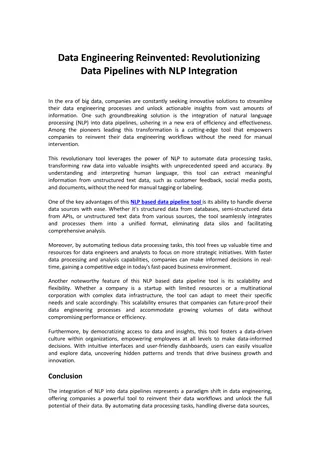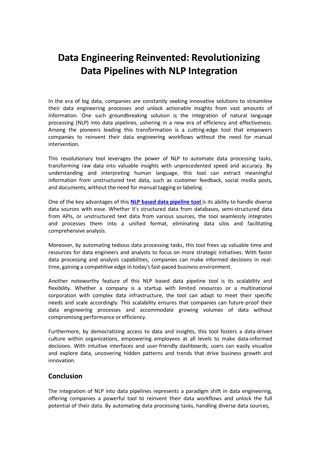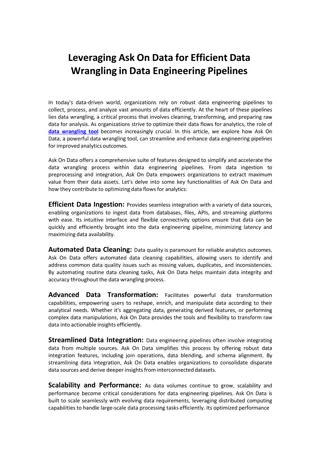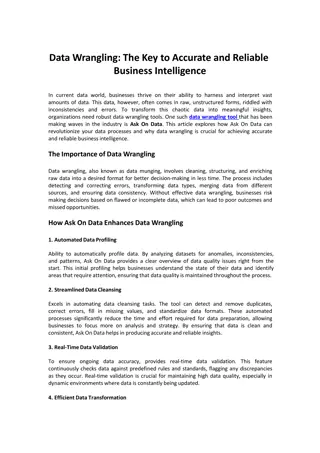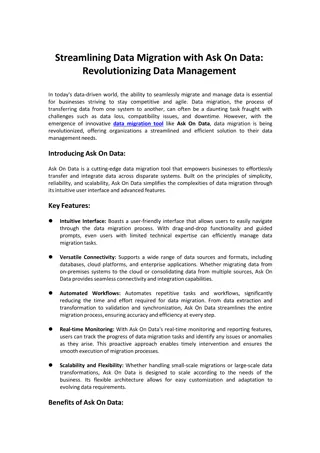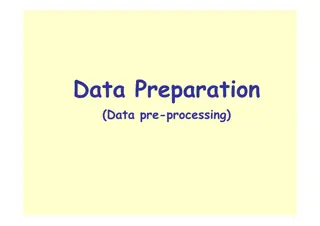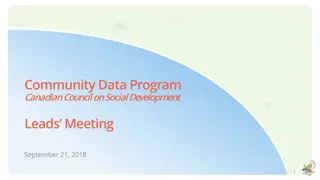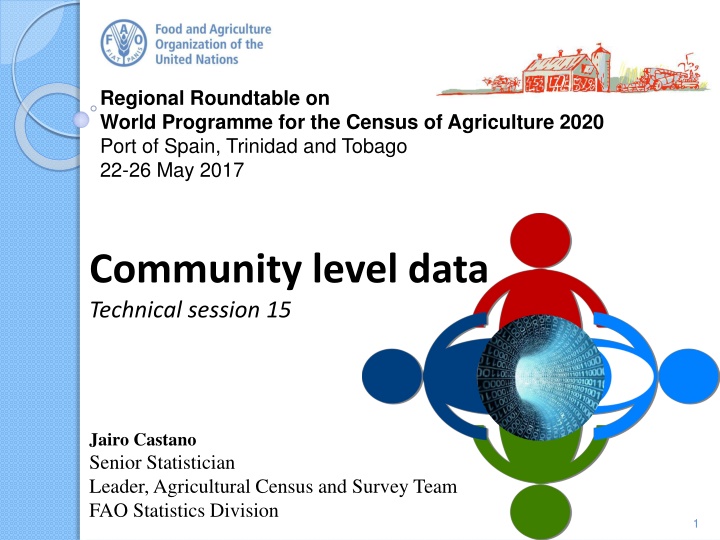
Community-Level Data Collection in Agricultural Surveys
Explore the significance of community-level data collection in agricultural surveys, including reasons, methodological considerations, and practical uses. Learn how this data aids in planning, monitoring, and evaluating agricultural development, rural initiatives, and food security policies. Discover the benefits of analyzing community data alongside holding-level data, and its impact on enhancing decision-making processes in agriculture.
Download Presentation

Please find below an Image/Link to download the presentation.
The content on the website is provided AS IS for your information and personal use only. It may not be sold, licensed, or shared on other websites without obtaining consent from the author. If you encounter any issues during the download, it is possible that the publisher has removed the file from their server.
You are allowed to download the files provided on this website for personal or commercial use, subject to the condition that they are used lawfully. All files are the property of their respective owners.
The content on the website is provided AS IS for your information and personal use only. It may not be sold, licensed, or shared on other websites without obtaining consent from the author.
E N D
Presentation Transcript
Regional Roundtable on World Programme for the Census of Agriculture 2020 Port of Spain, Trinidad and Tobago 22-26 May 2017 Community level data Technical session 15 Jairo Castano Senior Statistician Leader, Agricultural Census and Survey Team FAO Statistics Division 1
Contents Background Reasons for collecting and uses of community-level data Methodological considerations Items Tabulation Country experiences Conclusions 2
Background The collection of community-level data was first introduced in the WCA 2010. Countries are encouraged to collect community-level data along with holding-level data in the census of agriculture. The community survey is not part of the census enumeration, it is a separate operation: both exercises have different statistical units, data suppliers and specific objectives. Chapter 9 of the WCA 2020 (Vol. I) is devoted to community-level data. 3
Reasons for collecting and uses of community-level data (CLD) Community-level data are of interest for: Planning, monitoring and evaluation of agricultural and rural development and of food security policy (e.g. to support the solution of problems related to food-shortages, infrastructure problems of farmers and communities in general); Development partners to support rural development programs at national and subnational levels; Businesses; Identification of: areas where agricultural market or commercial network are needed; areas where agricultural services or processing facilities should be encouraged; vulnerable areas where there is a risk of food insecurity due to natural disasters; 4
Reasons for collecting and uses of community-level data (contd.) They can be analysed in relation to holding-level data taken from the census of agriculture (e.g. No. of holdings participating in farmers associations); They can be used to complement data collected at holding- level (e.g. agricultural land not belonging directly to any agricultural holding such as common agricultural land used for grazing (communal grazing land)); User-friendly presentation of results on maps using GIS; CLD can be collected at marginal cost as it involves mainly community administrations. 5
Methodological considerations What is a community? A community is a self-contained unit of social and economic activities. What statistical units should be chosen for a community survey? Unit chosen for community survey depends on: Data collected: sometimes, the lowest admin. unit has no substantial admin. function, and the community unit may need to be defined at a higher level. Cost: may influence whether to collect data at, for example, the commune or village level. Identifying community units: ready access to lists of community units needed. Stability of community units: difficulties when changes in admin. units are common and not well-coordinated. Census coverage: Countries should endeavour to cover the communities where census enumeration is conducted. 6
Community data collection How to collect community-level data will depend on the organization of field work for the collection of holding-level data. Informants will be community officials or other relevant persons. The most experienced of the supervisors or enumerators in charge of census data collection could be assigned in advance to administer the community questionnaire. Could take place when the community administration prepares the list of households or holdings for the agricultural census. Often, community officials help locate each household or help as translators. Community questionnaire can then be collected. Consideration should be given to the suitability of collecting community-level data by mail, rather than by interview. 7
Recommendations of WCA 2020 on Community Level Data DOs Link agricultural census with existing community databases and other available reliable administrative and statistical data sources to avoid duplication. CLD should be limited to key admin. information that are well- known to people in the community such as weather conditions, economic activities, presence of infrastructure and services. The number of community-level items should be kept to a minimum, normally, 10-20 items. In designing the community survey, tabulation needs should always be considered. Community-level data are only useful if they can be presented in statistical summaries 8
Recommendations of WCA 2020 on Community Level Data (cont.) DON Ts The community survey should not be used for collecting: data available from other reliable statistical and administrative data sources; that are better collected directly from holdings. Communities should not be asked to report the same data as holdings. The only exception could be land use data from community records. If they are deemed to be of good quality and their concepts and definitions are compatible with those adopted for the agricultural census, they could be used for checking at the aggregate level the land use data reported by holdings. 9
Community-level items Geography Location, agro-ecological, climatic, topographical or soil types; land use; area of communal grazing land; area of communal forest; communal area under water used for aquaculture; travelling time and mode of travel to the major nearest urban centre; whether the community has a year-round access to the nearest urban centre; whether the community is prone to natural disasters. Socio-economic conditions Population according to population group; number of households; economic status, main economic activities; whether there are seasonal food shortages. 10
Community-level items (contd.) Community infrastructure and services Presence of (or travelling time to the nearest): fertilizer dealer; pesticide dealer; seed dealer; credit institution; agricultural produce market; food storage facilities; agricultural processing facilities; facilities for maintaining agricultural machinery; extension services; primary school, health facility Presence of irrigation facilities & area equipped for irrigation Availability of (or travelling time to the nearest) veterinary services. Whether the community is covered by agricultural produce collection network Existence of farmers associations, cooperatives and other supporting bodies. Whether electricity is connected. Presence of radio, telephone and internet services Availability of public transport Development programmes Presence of specific development projects in the community, for example an irrigation or an rural electrification project. 11
TABULATION Community level data can be tabulated in 2 ways: 1. Summarize the characteristics of communities; 2. To use as classification variables for tabulations of census holding-level data (crucial to be able to link each holding with its community). 12
TABULATION (contd.) For the second case, typical community level classification variables are: Access to urban centre Risk of natural disasters Economic status Occurrence of seasonal food shortages Presence of periodic or permanent agricultural produce market Access to veterinary services Access to farm input trading centre Access to credit institutions Access to farmers association Presence of specific development projects. 13
Country experiences Nicaragua- IV National Agricultural Census 2011 Coverage: the community survey covered 5,440 rural communities , a unit below comarca (county). Items: The questionnaire covered 6 main sections. 1. 2. 3. 4. 5. 6. Geographical location of the community Respondent identification Road access and transport in the community Ethnicity and environment Availability of agricultural services Availability of health, education and communication services 14
Country experiences Haiti Census of agriculture 2008-2009 The Enqu te Communautaire covered communal sections , a unit below commune . Main sections: 1. Location and respondent ID 2. Land use and main crops 3. Environment and natural risks 4. Roads, transport, water & electricity 5. Access to basic services (health, education) 6. Processing facilities 7. Main markets 8. Natural/cultural sights and festivities 9. Main economic activities 10. Availability of inputs, extension services and credit 11. Agricultural employment 12. Social cohesion, integration and conflicts 13. Food security 14. Development projects 15. Villages and residential areas 15
Conclusions Advantageous to conduct community survey along with the agricultural census. Limited additional cost, but results are much useful for planning of targeted development programmes at national and subnational levels and appreciated by development partners. CLD are important for both short-term and long- term policies in food security and agricultural and rural development. User-friendly presentation using GIS. 16
MANY THANKS 17



